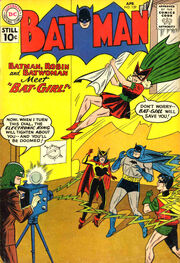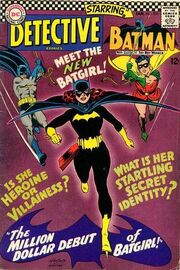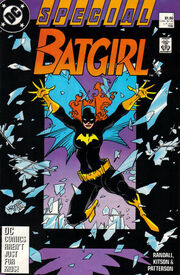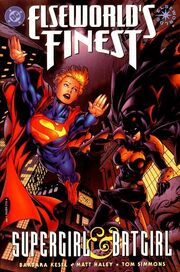History
Comics
Although Batman adopted Robin in Detective Comics #38 (1940), only ten issues after his first appearance, two decades would pass until the appearance of Gotham City's first female crime-fighters.
Pre-Crisis
Bette Kane

Bat-Girl makes it to scene
As soon as 1961, DC was trying to introduce a female version of Robin. So, in Batman #139, Bill Finger and Sheldon Moldoff introduced Bat-Girl (with a hyphen). Betty Kane was Kathy Kane (Batwoman)'s nieve and biggest fan. Wishing to emulate her aunt, Betty made her own costume and gadgets and set out to fight crime.
Unfortunately the character didn't become popular and would make her last regular appearance in Detective Comics #322 (1963).
Barbara Gordon

Barbara Gordon's first appearance
On 1966 Batman live-action show premiered and became an instant hit. Two years later, though, the ratings started to slip, and the show's producers asked DC to create a new Batgirl so she could be added to the series.
Thus, in Detective Comics #359 (January, 1967) debuted the most popular character to ever take up the Batgirl mantle. Created by Julius Schwartz, Gardner Fox and Carmine Infantino after a concept by William Dozier, Barbara Gordon was James Gordon's daughter, as well as the head librarian at the Gotham City Public Library and a martial arts practitioner, Barbara lamented her boring life. One night she slipped on a Batgirl costume to attend a masquerade ball, and on her way she ran into Killer Moth attempting to kidnap Bruce Wayne. Barbara would interfere with the villain and help Batman and Robin bust Killer Moth's protection racket.
In the process Barbara realized she loved the thrill of crime-fighting and became another ally to Batman and Robin. Just like Batman and Superman were the World's Finest, Batgirl was often partners with Supergirl
"Batgirl" became a regular backup feature in Detective Comics #384 (1969), as well as the Batman Family book, being finally retired in Detective Comics #519. Throughout those years, Barbara would change careers several times -becoming Congresswoman and later activist-, and would eventually reveal her identity to her father in Detective Comics #422.
Unfortunately, despite immense popularity, DC decided to retire the character in the early 80's, motivated by their plans to reboot their comic-book line. Some while after her final strip, Barbara Gordon would quit after a failed mission. In DC Comics Presents #86/Crisis on Infinite Earths #4, Barbara Gordon met Kara Zor-El for the last time and admitted she was frightened in the face of cosmic annihilation. In spite of her feelings of helplessness and worthlessness, Batgirl would survive the Crisis whereas Supergirl would die in battle in Crisis on Infinite Earths #7. Batgirl delivered the eulogy in her funeral.
Post-Crisis
Barbara Gordon

The Last Batgirl Story
AFter the Crisis, the Batman franchise was soft-rebooted. Due to Frank Miller forgetting about Barbara Gordon while penning Batman: Year One, Batgirl's backstory was forcefully redefined in Secret Origins (Volume 2) #20 (1987). Now she was James Gordon's niece and adoptive daughter, and she was friends with Power Girl instead of Supergirl.
Shortly later, though, Alan Moore would be given permission to cripple Barbara Gordon in Batman: The Killing Joke. Prior to that, Barbara Kesel was hired to reveal the circumstances of Barbara's retirement in Batgirl Special #1, published as a send-off of Barbara's career as Batgirl. "The Killing Joke" came out only a few days later, featuring the Joker shooting Barbara through the spine.

An Elseworlds Team-up
Nonetheless, even though Barbara would be reinvented as Oracle by John Ostrander in Suicide Squad #23 (1989), DC still published stories featuring her as Batgirl during the 90's: Batman: Batgirl (1997), Batman: Batgirl (Volume 2) #1 (1998), The Batgirl Adventures #1 and Elseworld's Finest: Supergirl & Batgirl #1 (1998) are some few examples.
In 2003, Chuck Dixon and Scott Beatty wrote Batgirl: Year One, which redefined and expanded on her origin, introducing some changes.
Minor Torchbearers
During Barbara Gordon's Oracle era, some other women tried to take up the Batgirl mantle: Huntres took the position in Batman: Shadow of the Bat #83 during Batman: No Man's Land but later relinquished it.
Misfit briefly called herself Batgirl when she started her vigilante career on the streets, although she changed her name after she was taken in by the Birds of Prey in Birds of Prey #96 (2006).
Cassandra Cain
Stephanie Brown
Links and References
Template:Batgirl Links
